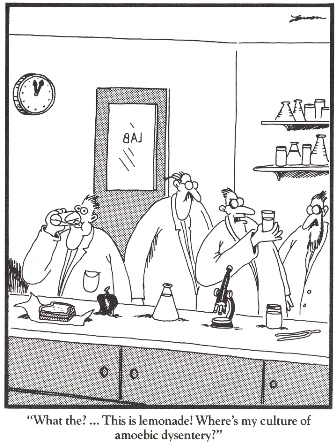Quite a few people have asked me if the full curcumin-H1N1 study mentions which curcumin dose works against H1N1. No, unfortunately, it doesn’t. This is an in vitro study…infected cell cultures and test tubes and big-name assays and the usual technical thises and thats. The authors do say, however, that the doses they used were below the cytotoxic (=toxic to cells) level. I will see if I can find something more helpful in the study later on today.
By now, everywhere we go, we are bound to run into coughing and sneezing people. In fact, whenever I think about it, I find it extraordinary that, in spite of my almost nonexistent immune system (=as I wrote the other day, my hematologist was astounded that I wasn’t ill all the time), I am as healthy as a horse, whereas my students are falling one by one, like leaves in autumn. I won’t hide that I am apprehensive, but so far I haven’t had even the slightest of sniffles. Is it my daily intake of curcumin? Is it the Broncho Munal that I began taking in September (I am at the end of the third and final cycle now)? Is it my increased intake of vitamin D3? Or is the H1N1 virus being scared away by the mere presence, in my house, of a bottle of Sambucol (=black elderberry extract)? I have no idea. Whatever it is, though, it is working…and I hope it continues to do so (knock on wood, tocca ferro)!
Since I am still reading, writing and doing research (ah, don’t even ask about the curcumin-esophageal study…mamma mia, that one had me spinning in so many different directions that I had to shove it into a drawer for the time being, just to catch my breath!), I thought I would give you the link to a HealthDay article on a fascinating, recently-published, er, sneezing study: http://tinyurl.com/ydn7tkn
It’s amazing to think how much we are influenced by, and fearful of, a sneeze or a cough…from now on, perhaps we should try to remember what one of the study authors says (see above link): “about one out of 80 people have gotten H1N1,” which means that “there’s a 79 out of 80 chance the person you heard sneeze doesn’t have it.”
To this, let me add that Dr. Ugazio, President of the Italian Pediatric Association’s Vaccine Committee, said yesterday in an interview that H1N1 is a “media-hyped virus,” and that the regular flu kills ten times as many people (hmmm, not a comforting thought, actually). He is absolutely right…you wouldn’t believe the H1N1 media frenzy going on right now here in Italy…
Still, I can’t help it…the mere thought of someone sneezing or coughing in my vicinity makes me run for my bottle of curcumin…
